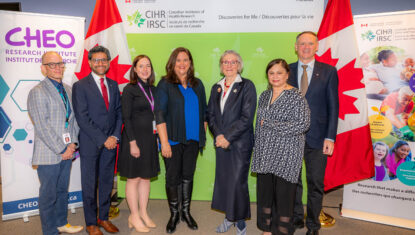Our Multidisciplinary Approach
Mental Health Research at CHEO integrates the three pillars of our mission of high quality clinical care, ground-breaking research, and the education of the next generation of clinical scholars. A number of active research groups exist in psychiatric emergency services, eating disorders, ADHD, pediatric-mental health interface, and knowledge mobilization and outcomes management. Among the research scholars are local, provincial, national, and international leaders of research in child and youth mental health. All of the research enterprises are fully embedded in clinical practice creating the opportunity for the mental health community to be the type of learning environment expected in one of Canada’s leading pediatric teaching hospitals.
Mental Health in the Emergency Department
While 15% of children and youth live with a mental illness, only 1 in 6 receives any substantial mental health services. Emergency Departments (ED) are increasingly becoming a primary source to obtain mental health services for children and youth. Some researchers propose that this increase is due to lack of inpatient and outpatient mental health services. The range of mental health emergency services provided and the subsequent direct and indirect follow-up care after discharge from the emergency department varies with limited understanding of the factors that influence clinical decision making. The long-term goal of this research is to develop evidence-based practice and clinical guidelines for the delivery of ED mental health services for children and youth.
Related News
-

04/03/2024
CHEO Research Institute leading the way with precision child and youth mental health initiative
-

14/09/2023
Heavy social media use linked to higher psychological distress, particularly for younger teens
-

04/05/2023
Dr. Nicole Racine awarded $1.2M project grant through CIHR’s Mental Health in the Early Years initiative
Research Projects
-
HEADS-ED Under 6: A clinician-administered mental health and developmental screening and triage tool
03/04/2025
It is estimated that 10% to 25% of children under the age of 6 years have mental health (MH) concerns (1–5). In young children, MH risk factors may include eating and sleeping problems, late or abnormal development, attachment issues, adverse childhood experiences, behavioural or emotional dysregulation, language delays, and unstable or unsafe home environments (5–7). However, the challenge of measuring prevalence of MH concerns during infancy and early childhood is partially due to low identification rates by health professionals (4,8,9). When clinicians assess infant MH, they can provide resources to parents and/or refer families to specialists if red flags are identified (7). Health professionals who rely solely on clinical judgement detect less than 30% to 50% of MH problems (8); thus, one way to increase early identification and assist with clinical decision-making may be for primary care providers and pediatricians to use MH screening tools (7,10,11).
-
Improving transitions in care for children and youth with mental health concerns: implementation and evaluation of an emergency department mental health clinical pathway
31/03/2025
The emergency department (ED) is a common access point for children and youth seeking mental health (MH) and addiction care [1]. Pediatric MH visits to EDs have significantly increased since 2009 in Ontario, Canada [2,3,4]. Over 50% of children and youth use the ED as the first contact for MH concerns without previously seeking outpatient care, with many patients returning to the ED to seek additional care [5]. Although families increasingly rely on EDs for MH care, these settings are often unprepared to manage children and youth with urgent and emergent MH concerns [5]. EDs lack standardized screening tools, clinical resources, and clinicians trained to confidently manage pediatric MH patients [5,6,7]. Adding to this problem is the complex and fragmented MH system in Canada, which creates difficulty in providing a coordinated transition for patients between the ED and community services. The lack of streamlined referral processes to MH resources in the community results in ED clinicians discharging their patients without appropriate recommendations for follow-up care based on their needs [8]. Each of Ontario’s 33 geographical service areas have lead agencies that are responsible for ensuring that core child and youth MH services are available to their respective communities. Lead agencies can directly deliver these core services or work in partnership with other core service providers in their communities to develop and strengthen pathways to care. Pathways between lead MH agencies and EDs have been established in Ontario and are evolving, but many gaps in care remain.
-
Physician Follow-Up of Pediatric and Young Adult Emergency Department Visits for Substance Use in Ontario, Canada
01/11/2024
-
Virtual psychoeducation for improvement of pain catastrophizing in pediatric presurgical patients and caregivers: A proof-of-concept study
03/10/2024
Youth (n = 43) and caregivers (n = 41) attended a virtual, group-based single-session intervention (SSI). Single-session intervention content addressed pain neuroscience, PC, and adaptive coping strategies for managing pain and PC drawn from cognitive-behavioural, acceptance and commitment, and dialectical behaviour therapy approaches. Participants completed questionnaires assessing PC at preintervention, postintervention, and two weeks postsurgery. Youth mood and anxiety were assessed at preintervention.
-
The HEADS-ED under 6: Piloting a new communimetric mental health and developmental screening and triage tool for young children
10/08/2024
Caregivers are critical to recognizing early mental health (MH) and developmental concerns in their infants and young children and communicating these concerns to their primary care physician. Early risk factors for infant MH concerns can include sleep problems, eating difficulties, abnormal development, attachment issues, emotional or behavioral outbursts, and language concerns (Skovgaard et al., 2006). Pediatricians and primary care providers also play an important role in the early identification of these risk factors and in making referrals to services that can meet their needs (Parkhurst & Friedland, 2020). The Canadian Pediatric Society's MH Task Force (Canadian Pediatric Society, 2023) set out to identify available MH screening tools. Among the tools for infants, one clinician interview and seven parent-report MH screening tools were available and take under 20 min to complete. Upon review of these and other MH screening tools for children under the age of 6 that identify important concerns (Ammitzbøll et al., 2016; Szaniecki & Barnes, 2016), none are created with the intent of communicating needs and action that should be taken for service recommendation and provision.
-
Associations between problem technology use, life stress, and self-esteem among high school students
16/02/2024
Adolescence marks a critical biological, social, and psychological growth and development period. Adverse influences on emotional and psychological well-being can thus impair healthy development within this period of vulnerability [1, 2]. Significant links between self-esteem and life stress have been identified, with both high life stress and low self-esteem during adolescence being strong predictors of poor health and development [1, 3, 4]. These adverse effects include an increased risk of developing mental health disorders such as depression and anxiety [3, 5]. Additionally, problem technology use, which refers to technology usage in a manner which elicits biopsychosocial harm, has also been associated in a systematic review with poor health and developmental outcomes due to adverse effects on sleep and mental health [6].
-
Closing the Referral Loop: Piloting a Clinical Pathway Between Primary Care and Community-Based Mental Health and Addictions Services
21/01/2024
-
Components of Outpatient Child and Youth Concurrent Disorders Programs: A Critical Interpretive Synthesis:
09/11/2023
Concurrent disorders, defined as co-occurring mental health and substance use disorders (SUDs), are often underrecognized, undertreated, 1 and lead to significant patient morbidity and mortality, and costs to the healthcare system.2,3 Children and youth aged 15–24 experience the highest rates of mental illness and substance use compared to any other age group, 4 as well as higher rates of concurrent disorders. 5 Previous studies suggest that more than 60% of children and youth with a SUD have a comorbid psychiatric disorder,6,7 such as attention deficit hyperactivity disorder, anxiety disorders, mood disorders, impulse control disorders, or psychotic disorders.7,8 It is estimated that while 15% of adolescents in the general population report symptoms of a substance use problem, less than 1% report receiving treatment in the past year. 9 Moreover, children and youth with concurrent disorders are less likely to access services than those without this comorbidity, due to difficulty connecting with the appropriate services, requirements of abstinence for receipt of services, and exposure to stigmatizing attitudes within the health care system.10,11 The risks of untreated concurrent disorders in young people are well established and include interpersonal difficulties, school drop-out, engagement in risky or illegal activities, hospitalization, and suicide.12-16 In contrast, treatment of concurrent disorders in children and youth has lasting effects and has been shown to reduce mental health and SUD diagnoses and emergency department visits up to three years later. 17
-
Impact of a publicly-funded pharmacare program on prescription stimulant use among children and youth: A population-based observational natural experiment.
27/10/2023
Prescription drug coverage is a less well-studied determinant of medication access among individuals with ADHD. In one US study, children without insurance were less likely to be prescribed stimulants than those with private or public insurance. Similarly, a separate US study found that most stimulant prescriptions were paid through commercial insurance, with copayments required for nearly two-thirds of prescriptions dispensed. Therefore, disparities in insurance status may be an important source of inequity in treatment for children and youth with ADHD, favouring individuals with private insurance and the financial resources to cover out-of-pocket costs. This assertion is supported by findings from research associating higher income with a greater likelihood of stimulant treatment and lower treatment rates in children with ADHD from low-income families despite being at least as likely to meet the diagnostic criteria for this condition as high-income children.
-
Mental health treatment programs for children and young people in secure settings: A systematic review
12/10/2023
The commonalities across secure treatment programs appear to stem from them being designed around a need for treatment that includes a mental disorder, symptom severity and salience involving significant risk of harm to self and/or others, and a proportionality of the risks and benefits of treatment. Most share a common logic; however, the evidence suggested that this logic may not to lead to sustained outcomes. Policymakers, service providers, and researchers could use the offered recommendations to ensure the provision of high-quality secure treatment programming to children and young people with serious and complex mental health needs.
-
Electronic health records identify timely trends in childhood mental health conditions.
14/09/2023
Our interdisciplinary team of experts in informatics and Child and Adolescent Psychiatry collaborated in assessing the utilization of available, aggregated, standardized EHR data in identifying and tracking the full diagnostic spectrum of MH disorders/symptoms and exposure to ACEs, over time, across multiple sites and identifying groups at risk by year and demographics. This study necessitated the development of an EHR-based pediatric MH condition typology that expanded on the Diagnostic and Statistical Manual of Mental Disorders (DSM) by including Intentional Self-Harm, Catatonia, Encephalopathies, Standalone Symptoms, Tic Disorders, added exposure to ACEs, and that took into account the 2015 U.S. healthcare transition to the International Classifications of Diseases (ICD-10) [13]. This involved assembling clinical codes representing single diagnoses and symptoms from the Systematized Nomenclature of Medical Clinical Terms (SNOMED CT) [14, 15] which were then cross-mapped to ICD-9 [16] and ICD-10 [17] and checked for omission, commissions and alignment with DSM-5 [18].
-
Trends in Rates of Opioid Agonist Treatment and Opioid-Related Deaths for Youths in Ontario, Canada, 2013-2021
06/07/2023
The overdose crisis across North America continues to worsen. While opioid-related deaths concentrate among middle-aged adults, recent data suggests an acceleration in opioid-related mortality among youths.1,2 Opioid agonist treatment (OAT) is a core response to this crisis as it is an evidence-based treatment shown to reduce opioid-related and all-cause mortality among individuals with opioid use disorder (OUD). Despite recommendation for its use,3 there are barriers to accessing OAT among youths, including: stigma, burden of witnessed dosing, and lack of availability of youth-oriented services and prescribers comfortable treating this population.4-6 Given the rising burden of opioid-related mortality in younger demographics, and the known barriers to accessing OAT in this population, we sought to contrast rates of OAT and opioid-related mortality between youths aged 15 and 24 years and adults aged 25 to 44 years in Ontario, Canada.
-
Heavy social media use and psychological distress among adolescents: the moderating role of sex, age, and parental support
04/07/2023
The current study is a secondary data analysis of the 2019 Ontario Student Drug Use and Health Survey (OSDUHS) (46). This representative cross-sectional school-based survey included Ontarians in grades 7–12 from English and French public and Catholic schools (n = 14,142). Two hundred sixty-three schools from 47 public and Catholic school boards participated in this survey. Ethics approval was obtained from the Research Ethics Boards of the Center for Addiction and Mental Health (CAMH; 029/2016), York University (e2014-099), and 47 public and Catholic school boards’ research review committees. Participation in the survey required active parental written consent and student assent. The survey was completed anonymously during school time.
-
Associations Between Type and Timing of Physical Activity and Sedentary Behavior With Mental Health in Adolescents and Young Adults
23/06/2023
Leisure-time PA was found to have a favorable association with mental health, particularly in the evenings of weekdays and afternoons of weekend days. On the other hand, leisure SB was associated with poorer mental health in most of the time segments analyzed, and nonleisure SB in the evenings was also related to worse mental health. The type and timing of PA and SB behaviors play an important role in the relationship with mental health.
-
A Primary Care Mental Health Pathway for Children and Youth: A Mental Health Services Quality Improvement Initiative in Ontario
07/06/2023
-
Meeting the service needs of youth with and without a self-reported mental health diagnosis during COVID-19
01/05/2023
The COVID-19 pandemic has introduced multiple, co-occurring stressors for youth, such as drastic changes to their daily routines, social interactions, and educational conditions (1,2). Relative to other life stages, adolescence is a critical period of social and emotional development (3), and one in which mental health (MH) and substance use disorders are more likely to emerge in the face of overwhelming change (4). For many youth, it seems that the MH impacts from COVID-19 have been detrimental (5–8). For others, their MH may not have changed, or even improved, due to fewer social or school-related pressures or increases in family bonding (9–12). For youth with existing MH concerns, diagnoses or risk factors, the MH effects of the pandemic may have been especially harmful (9,13,14), particularly for those whose access to services has been discontinued or disrupted (13).
-
Longitudinal associations between different types of screen use and depression and anxiety symptoms in adolescents
28/04/2023
Higher screen time was longitudinally associated with higher anxiety and depression symptoms at one-year follow-up in adolescents. Time-change associations between screen usage and depressive and anxiety symptoms were observed. Also, associations differed based on sex and screen type, whereby greater increases in screen use predicted greater emotional distress. Findings from this prospective analysis suggest that screen time is an important determinant of anxiety and depressive symptoms among adolescents. Future studies are recommended to help inform programs promoting screen time reduction with a goal to enhance adolescents’ mental health.
-
Youth engagement in child maltreatment research: Gaps, barriers, and approaches
10/03/2023
Growing evidence suggests that putting the priorities of youth at the forefront of research enhances the quality, relevance, and impact across all stages of the research process.
-
Pediatric emergency department physicians’ perceptions of virtual mental health assessments for urgent needs
07/02/2023
While many physicians agreed that there is a potential benefit of the ED virtual care platform for urgent mental health assessments, time constraints and lack of confidence in providing satisfactory virtual mental health care with minimal mental health support limited its acceptability. These findings can inform the future implementation of mental health services using an innovative virtual ED platform.
-
The effects of reducing social media use on body esteem among transitional-aged youth
01/02/2023
-
Attachment insecurity predicts outcomes in an ACT-CBT group therapy for adults in a physical rehabilitation centre
29/12/2022
Chronic illnesses and disabilities (CID) are defined as illnesses or health conditions of long duration that can interfere with overall functioning and health-related quality of life (HRQoL). The global disease, injury, and disability burden has long been high at the individual and societal levels (Haagsma et al., 2016; Vos et al., 2015), and is projected to increase (World Health Organization, 2014). Global trends including a rising life expectancy, an increase in non-communicable diseases, and most recently the Covid-19 pandemic have accelerated the growth of CID-related morbidity and mortality rates worldwide, leading to the highest prevalence of people living with functional impairment, disability, and decreased HRQoL than ever before (de Oliveira Almeida et al., 2022; Hacker, Briss, Richardson, Wright, & Petersen, 2021; Stucki, Bickenbach, Gutenbrunner, & Melvin, 2018). Effective, accessible, and cost-effective interventions are needed to help improve functioning and HRQoL in individuals living with CID.
-
Building Resilience and Attachment in Vulnerable Adolescents: A Pilot Trial of a Brief Group Intervention for Adolescents with Mild to Moderate Suicidal Ideation and their Caregivers
11/11/2022
Study results demonstrate that the BRAVA intervention has the potential to reduce SI among adolescents who present to hospital services in crisis. Further studies are required to establish BRAVA's efficacy in a randomized controlled trial.
-
A stochastic optimization approach for staff scheduling decisions at inpatient units
26/10/2022
In this paper, we propose an optimization scheme in order to schedule the operations of the orthopedic surgery division at Habib Bourguiba University Hospital. This type of planning could be performed for a general problem of scheduling “n” operations in “m” operating rooms and “b” recovery beds with the conditions that: m ⩽ b, longer operation takes longer recovery time and no wait as much as possible between the operating room and the recovery room.
-
Sociodemographic and mental health characteristics associated with changes in movement behaviours due to the COVID-19 pandemic in adolescents
02/10/2022
Ongoing efforts continue to be made to understand the potential impacts of COVID-19-related preventative public health measures. This large cross-sectional study is among the first to describe the sociodemographic and mental health characteristics of Canadian adolescents in relation to perceived changes in movement behaviours during the months immediately following introduction of lockdown measures. The survey capturing responses of students across Ontario, Quebec, and British Columbia (Canada) found that a perceived increase in screen time as a result of the pandemic was highly prevalent, with social media increase among females compared to males having the largest effect size among gender-based comparisons of movement behaviour changes.
-
Physician Perspectives on the Implementation of a Trauma Informed Care Initiative in the Maternity Care Setting
18/08/2022
Building on previous research, physicians were concerned about the time required to engage in conversations about trauma with patients (Flanagan et al., 2018; Purkey et al., 2018). Interestingly, while time management was a concern, physicians also acknowledged that not every case required additional time. Specifically, some physicians identified that some patients may require more time to discuss concerns while others did not feel the need to have detailed discussions about their past experiences
-
Cyberbullying involvement, parental support, and cannabis use among adolescents
13/08/2022
Our results showed that cyberbullying involvement in any role (i.e., cyberbullying victim only, cyberbullying perpetrator only, or cyberbullying perpetrator-victim) was associated with greater odds of cannabis use after adjusting for important covariates. Results further indicated that higher parental support was associated with lower odds of cannabis use in a dose-response fashion. Higher parental support was also associated with a lower risk of cyberbullying involvement.
-
Appearance satisfaction mediates the relationship between recreational screen time and depressive symptoms in adolescents
18/07/2022
Recreational screen time, including activities that involve using a screen for leisure (i.e., computer, videogames, television; U.S. National Library of Medicine, 2018) is a popular and predominantly sedentary pastime. Epidemiological data show that many adolescents exceed the <2-hr daily screen time recommendation based on the Canadian 24-hr Movement Guidelines for Children and Youth (Tremblay et al., 2016) by more than 6 hr each day (Leatherdale & Harvey, 2015). As screen time activities exert increased influence on adolescents' lives, it has spurred researchers to examine the implications of their use. High levels of recreational screen time activities have been associated with a host of physical health issues, such as sleep problems (Cabre-Riera et al., 2019), health risk behaviors, (i.e., illicit drug use; Rücker, Akre, Berchtold,& Suris, 2015) and risk of overweight status and obesity (Fang, Mu, Liu, & He, 2019). Alarmingly, one additional hour of daily screen time has been linked to 172 additional servings of beverages high in sugar and 368 additional servings of ‘unhealthy’ snack foods each year among adolescents (Hicks, Jillcot Pitts, Lazorick, Fang, & Rafferty, 2019).
-
The Canadian 24-hour movement guidelines and self-rated physical and mental health among adolescents
01/04/2022
The objective of this study was to examine the associations of meeting combinations of these recommendations with self-rated physical and mental health.
-
Parenting during the COVID-19 pandemic: The sociodemographic and mental health factors associated with maternal caregiver strain
03/01/2022
Introduction: The COVID-19 pandemic has introduced new stressors for parents (“caregivers”) that may affect their own and their child’s mental health (MH). We explored self-reported levels of caregiver strain (parents’ perceived ability to meet parenting demands), and the MH and sociodemographic factors of caregivers to identify predictors of strain that can be used to guide MH service delivery for families.
-
When the Bough Breaks: A systematic review and meta-analysis of mental health symptoms in mothers of young children during the COVID-19 pandemic
28/12/2021
-
Examining the Bidirectional Association Between Body Esteem and Body Mass Index During Adolescence
01/11/2021
The decreasing trajectory of body esteem over time suggests the need for prevention efforts to improve body esteem throughout adolescence.
-
Evaluating the sector-wide implementation of virtual child and youth mental health services in response to the COVID-19 pandemic: Perspectives from service providers, agency leaders and clients
08/10/2021
Virtual care, the use of internet and related technology to deliver mental health services, has the potential to improve access (Comer & Myers, 2016), efficacy and empowerment, and reduce costs (Leblanc et al., 2019). In recent years, service providers in Ontario's child and youth mental health sector have been exploring how best to integrate virtual care options into service delivery. The emergence of the COVID-19 pandemic accelerated these efforts. To continue to meet the needs of children, youth, and families during the pandemic, most service-providing agencies rapidly shifted to deliver virtual care. Prior to the pandemic, efforts were already underway to support the implementation of virtual care across Canada (Lal, 2019). The Mental Health Commission of Canada (MHCC) developed a virtual care/e-mental health toolkit which included frameworks for staff training and evaluation of various digital technologies (McGrath et al., 2018). In Ontario, psychiatric services, specialist consultations and training events are delivered to those in remote locations through the Ontario Telemedicine Network (OTN) (Serhal et al., 2017). Similarly, the Project Extension for Community Healthcare Outcomes (Project ECHO) focusing on child and youth mental health (CYMH) in Ontario promotes knowledge-sharing between primary care physicians and clinicians using a virtual platform (Serhal et al., 2018). Both services are funded by the government of Ontario. Online psychotherapy based on cognitive behavior therapy videos combined with coaching supports has been recently launched and funded by the government for youth ages 15 to 18 years (https://bouncebackontario.ca/).
-
Motivational Interviewing and the Use of Psychological Services Among Youth With Chronic
01/10/2021
All specialized pediatricians have a role to play in ensuring that at-risk youth with CMCs receive the psychiatric support they need.
-
Attachment avoidance and health-related quality of life: Mediating effects of avoidant coping and health self-efficacy in a rehabilitation sample.
13/09/2021
Participants in this study included adults referred for psychological services at a tertiary care physical rehabilitation center between 2016 and 2020. Ninety adults completed measures of attachment anxiety and attachment avoidance, coping, health self-efficacy, and HRQoL at one time point. Results: Path analysis indicated that the proposed model fits the data well. Higher attachment avoidance was significantly related to lower HRQoL, as mediated by higher avoidant coping and lower health self-efficacy. Conclusions/Implications: Results suggest that individuals high on attachment avoidance may require additional support to move toward psychosocial adaptation. Further research examining the role of attachment insecurity dimensions in adaptation to CID is warranted and should include longitudinal designs to replicate these findings. (PsycInfo Database Record (c) 2022 APA, all rights reserved)
-
Building Resilience and Attachment in Vulnerable Adolescents (BRAVA): a brief group intervention for adolescents with mild-to-moderate suicidal ideation and their caregivers
08/09/2021
Further studies are required to establish BRAVA’s efficacy in a randomized controlled trial.
-
Longitudinal association between movement behaviours and depressive symptoms among adolescents using compositional data analysis.
02/09/2021
Isotemporal substitution estimates indicated that decreasing screen time by 60 minutes/day and replacing that time with 60 minutes of additional sleep is associated with the largest change in depressive symptoms across all subgroups.
-
Associations between screen time and cognitive development in preschoolers
26/08/2021
Higher total screen time was unfavourably associated with working memory in preschoolers, while adherence to global and national screen time recommendations appeared to be a protective factor. Therefore, these findings provide further evidence for the importance of pediatricians and other health professionals discussing screen time recommendations with families, given these individuals are seen as a credible source for parents (32). Screen time was unrelated to expressive vocabulary in our sample.
-
Moving Towards Racial Equity in the Child and Youth Mental Health Sector in Ontario, Canada
30/07/2021
As we highlight these domains, we urge researchers, policy makers, and child and youth mental health service providers to work together to advance racial equity in meaningful ways.
-
Psychological and Demographic Determinants of Substance Use and Mental Health During the COVID-19 Pandemic
25/06/2021
These characteristics should be considered when developing prevention and treatment programs for adults with problematic alcohol use and comorbid anxiety and depression.
-
Coping in adolescents: A mediator between stress and disordered eating
16/06/2021
Overall, the findings from this study are among the first to demonstrate significant mediation relationships between stress (both negative life events and perceived stress) and ED symptomatology for emotion-oriented coping in both male and female adolescents. These findings suggest that using emotion-oriented coping in response to real or perceived stress increases the risk for ED symptomatology across all adolescents. These findings suggest that intervention or prevention efforts aimed at teaching adolescents how to tackle or cope with a problem by aiming to address the stressor itself (i.e. task-oriented coping) versus trying to escape the emotion that accompanies it may have a protective effect against emerging ED symptomatology, and likely full-blown eating disorders in the face of stress during a vulnerable developmental period.
-
Implementation and evaluation of a curriculum on the assessment and treatment of disruptive behaviour disorders
03/04/2021
Pre–post-evaluation of the curriculum showed improved knowledge in participants.
-
Psychiatric disorders in emerging adults with diabetes transitioning to adult care: a retrospective cohort study
12/02/2021
Prolonged gaps in care during transfer to adult care are common and may be associated with increased psychiatric disorder risk. Developmental factors associated with adolescence and emerging adulthood may further amplify this risk.
-
Psychological Correlates of Sedentary Screen Time Behaviour Among Children and Adolescents: a Narrative Review
09/12/2020
Practitioners, parents, policy makers and researchers should collectively identify and evaluate strategies to reduce screen time, or to use screens more adaptively, as a means of promoting better mental health among children and adolescents.
-
Development of a Clinical Pathway for the Assessment and Management of Suicidality on a Pediatric Psychiatric Unit
24/09/2020
This framework, developed with the aim to standardize care for psychiatrically admitted suicidal children and adolescents, may serve as a flexible template for use in similar settings and could be adapted according to local realities and resources.
-
Head to toe practice: Implementation and outcomes of a suicide screener in pediatric hospital inpatient units
19/08/2020
The hope is that this new practice will reduce emergency hospital visits for mental health crises and facilitate early access to mental health services.
-
Evaluating the psychometric properties of the parent-rated Strengths and Difficulties Questionnaire in a nationally representative sample of Canadian children and adolescents aged 6 to 17 years
19/08/2020
The original five-factor, parent-rated SDQ demonstrates evidence of factorial validity and reliability as a population measure of mental health difficulties among Canadian children and adolescents.
-
What’s the harm in asking? A systematic review and meta-analysis on the risks of asking about suicide-related behaviors and self-harm with quality appraisal
25/07/2020
Unfortunately, misperceptions of harm remain which can compromise clinical care, research, and public health surveillance efforts. Our objective was to evaluate the empirical evidence on whether and how asking about suicide related behaviors (SRB), such as suicidal ideation and suicide attempts, and non-suicidal self-injury (NSSI) results in harmful outcomes.
-
Medications for sleep disturbance in children and adolescents with depression: a survey of Canadian child and adolescent psychiatrists
01/03/2020
Melatonin and certain off-label psychotropic drugs are perceived as being more effective and appropriate to address sleep disturbances in children and adolescents with depression.
-
Exploring Acceptance and Commitment Therapy for parents of preterm infants
01/02/2020
One promising intervention that has not been explored in the NICU is Acceptance and Commitment Therapy (ACT), a behavioural therapy that has had positive mental health-related outcomes in similar parental populations.
-
Health outcomes associated with emergency department visits by adolescents for self-harm: a propensity-matched cohort study
06/11/2019
Adolescents with emergency department visits for self-harm have higher rates of mortality, suicide and recurrent self-harm, as well as higher health care costs, than matched controls.
-
The effect of high-intensity interval training on inhibitory control in adolescents hospitalized for a mental illness.
01/10/2019
The impact of pre-therapy HIIT to enhance focus and reduce impulsive thoughts and behaviours may improve adolescent patients’ response to mental health treatment.
-
Evaluation of eMentalHealth.ca, a Canadian Mental Health Website Portal: Mixed Methods Assessment
01/09/2019
Web analytic results showed that from January 1 to December 31, 2017, there were 651,107 users, with 1.97 million page views.
-
Health trajectories of children with severe obesity attending a weight management program
12/07/2019
Findings highlight the need to examine both mental and physical health outcomes beyond 1 year.
-
Changing Rates of Self-Harm and Mental Disorders by Sex in Youths Presenting to Ontario Emergency Departments: Repeated Cross-Sectional Study
01/06/2019
Rates of adolescents with self-harm and mental health ED visits have increased since 2009, with greater increases among females. Research is required on the determinants of adolescents’ self-harm and mental health ED visits and how they can be addressed in that setting.
-
Effects of weight teasing and gender on body esteem in youth: A longitudinal analysis from the REAL study
01/06/2019
Results suggest the weight teasing sources’ gender may differentially impact the victims’ body esteem, and highlights the need to consider these factors in weight teasing prevention strategies.
-
Obesity class versus the Edmonton Obesity Staging System for Pediatrics to define health risk in childhood obesity: results from the CANPWR cross-sectional study
02/04/2019
As BMI class increased, a concomitant increased disease burden in mechanical and social milieu issues was observed, whereas metabolic and mental health risks were high across BMI classes.
-
Embodied motherhood: Exploring body image in pregnant and parenting youth
01/02/2019
Future research exploring prepregnancy depression, eating disorder, body esteem, and depression in pregnant youth are needed.
-
Could long-term administration of melatonin to prepubertal children affect timing of puberty? A clinician’s perspective
31/01/2019
We conclude that to investigate an association between melatonin and pubertal timing, it will be important to conduct long-term randomized controlled trials of latency age children and also examine the cellular and systems-level interactions between melatonin and kisspeptin, a recently identified neuropeptide with a locus of action at the gonadotropin releasing hormone neurons that is important in contributing to the timing of puberty onset.
-
Evaluating Mental Health Service use During and After Emergency Department Visits in a Multisite Cohort of Canadian Children and Youth
21/01/2019
Children and youth and their families presenting to the ED with mental health needs had substantial clinical morbidity, were connected with services, were satisfied with their ED visit, and accessed follow-up care within 1-month with some variability.
-
Self-Inflicted Injury-Canadian Hospitals Injury Reporting and Prevention Program (CHIRPP-SI): a new surveillance tool for detecting self-inflicted injury events in emergency departments
11/10/2018
To assess the performance of the Canadian Hospitals Injury Reporting and Prevention Program’s newly developed self-harm surveillance tool (CHIRPP-SI) designed to improve emergency department (ED) hospital surveillance of youth self-inflicted injury (SI).
-
The mental health of adolescents and pre-adolescents living with inherited arrhythmia syndromes: A systematic review of the literature
01/05/2018
-
Sexual health of adolescent patients admitted to a psychiatric unit
01/04/2018
As many adolescents, particular those struggling with mental illness, do not attend preventative health visits, screening for pregnancy risk and other reproductive health needs is recommended at every adolescent encounter and in all settings.
-
Finding Ways Forward: Social Justice for Counsellors in the Evolution of a Collaborative Practice and Study Group
01/01/2018
The chapter is a demonstration of how an ethic of social justice plays out among counselors in a collective process of co-creating a study group uniquely suited to the needs of its members.
-
Brain on Fire: Incentive Salience, Hedonic Hot Spots, Dopamine, Obesity, and Other Hunger Games
21/08/2017
The surgical and pharmacological treatments of obesity are discussed, and evidence is presented for the selective use of DA-class drugs in obesity treatment.
-
Treat Me But Don’t Judge Me: A Qualitative Examination of Health Care Experiences of Pregnant and Parenting Youth
03/04/2017
To engage this high-risk population in health care, practitioners are encouraged to consider their own biases when servicing this population and work toward fostering positive, nonjudgmental interactions, and supportive environments.
-
Predictors of Repeated Visits to a Pediatric Emergency Department Crisis Intervention Program
30/08/2016
Repeat visits account for a large portion of all MH presentations to the PED. Furthermore, several patient characteristics are significant predictors of repeat PED use and of repeating use sooner and more frequently.
-
A Pilot Study of Citalopram Treatment in Preventing Relapse of Depressive Episode after Acute Treatment
01/02/2016
Subjects with depression who responded to open label treatment with citalopram in 12-week acute phase were randomized to continued treatment with citalopram or placebo for 24 weeks.
-
Effects of aerobic training, resistance training, or both on psychological health in adolescents with obesity: The HEARTY randomized controlled trial
31/08/2015
Resistance training, alone or in combination with aerobic training, may provide psychological benefits in adolescents with overweight or obesity, and therefore could be an alternative to aerobic training for some individuals in the biological and psychological management of adolescent obesity.
-
The HEADS‐ED under 6: Piloting a new communimetric mental health and developmental screening and triage tool for young children
Caregivers are critical to recognizing early mental health (MH) and developmental concerns in their infants and young children and communicating these concerns to their primary care physician. Early risk factors for infant MH concerns can include sleep problems, eating difficulties, abnormal development, attachment issues, emotional or behavioral outbursts, and language concerns (Skovgaard et al., 2006). Pediatricians and primary care providers also play an important role in the early identification of these risk factors and in making referrals to services that can meet their needs (Parkhurst & Friedland, 2020).
Researchers
-
Nick Barrowman
Associate Scientist, CHEO Research Institute
-
Maala Bhatt
Scientist, CHEO Research Institute
-
Addo Boafo
Investigator, CHEO Research Institute
-
Melanie Buba
Investigator, CHEO Research Institute
-
Annick Buchholz
Investigator, CHEO Research Institute
-
Christina Cantin
Scientist CHEO, Research Institute
-
Mario Cappelli
Investigator, CHEO Research Institute
-
Jean-Philippe Chaput
Senior Scientist, CHEO Research Institute
-
Michael Cheng
Investigator, CHEO Research Institute
-
Paula Cloutier
Investigator, CHEO Research Institute
-
Private: Evangeline Danseco
Investigator, CHEO Research Institute
-
Evangeline Danseco
Investigator, CHEO Research Institute
-
Poppy DesClouds
Investigator, CHEO Research Institute
-
Asif Doja
Investigator, CHEO Research Institute
-
William Gardner
Senior Scientist, CHEO Research Institute
-
Jeff Gilchrist
Associate Scientist, CHEO Research Institute
-
Gary Goldfield
Senior Scientist, CHEO Research Institute
-
Private: Stephanie Greenham
Investigator, CHEO Research Institute
-
Megan Harrison
Investigator, CHEO Research Institute
-
Allison Kennedy
Investigator, CHEO Research Institute
-
Christine Lamontagne
Investigator, CHEO Research Institute
-
Andrée-Anne Ledoux
Scientist CHEO Research Institute
-
Patricia Longmuir
Senior Scientist, CHEO Research Institute
-
Nathalie Major
Investigator, CHEO Research Institute
-
Danijela Maras
Investigator, CHEO Research Institute
-
Mark Norris
Investigator, CHEO Research Institute
-
Nicole Obeid
Scientist, CHEO Research Institute
-
Kathleen Pajer
Senior Scientist, CHEO Research Institute
-
Christine Polihronis
Investigator, CHEO Research Institute
-
Amy Porath
Investigator, CHEO Research Institute
-
Nicole Racine
Scientist, CHEO Research Institute
-
Ashley Radomski
Associate Scientist, CHEO Research Institute
-
Sarah Reid
Investigator, CHEO Research Institute
-
Phillippe Robaey
Scientist, CHEO Research Institute
-
Marie-Eve Robinson
Investigator, CHEO Research Institute
-
Tea Rosic
Scientist CHEO, Research Institute
-
Nicole Sheridan
Investigator, CHEO Research Institute
-
Noah Spector
Investigator, CHEO Research Institute
-
Wendy Spettigue
Investigator, CHEO Research Institute
-
Mark S. Tremblay
Senior Scientist, CHEO Research Institute
-
Sandy Tse
Investigator, CHEO Research Institute
-
Nancy Young
Senior Scientist, CHEO Research Institute
-
Roger Zemek
Senior Scientist, CHEO Research Institute











































